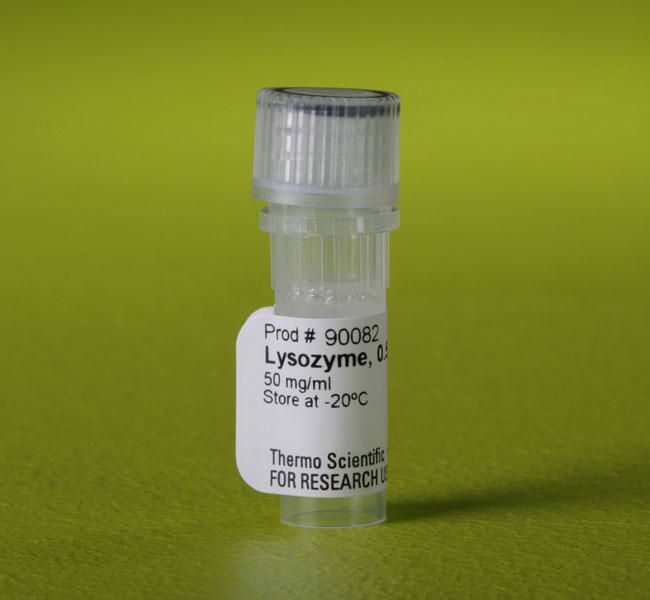Thermo Scientific™ Lysozyme Solution (50 mg/mL), 0.5 mL
Catalog No :
CAS Number :
Brand :
In Stock
Specifications:
| Application | Nucleic Acid Extraction | ||
| Storage Temperature | -20°C | ||
| Product Type | Enzymes | Forms | Liquid |
| Product Brand | Thermo Fisher Scientific™ | ||
| Product Grade | Molecular Biology | ||
The Thermo Scientific™ Lysozyme Solution is a high-performance enzyme solution designed to efficiently lyse bacterial cell walls, enhancing protein and nucleic acid extraction. Provided in a convenient liquid form, this enzyme solution ensures reliable and reproducible results across a range of molecular biology and biochemical applications.
Key Features:
- High Efficiency:
- Concentration: 50 mg/mL, delivering ≥50 units/mL activity at 5 μg/mL.
- Significantly improves the extraction of proteins and nucleic acids from bacterial cells.
- Enzymatic Activity:
- Hydrolyzes 1,4-β-linkages in bacterial peptidoglycan, targeting N-acetylmuramic acid and N-acetyl-D-glucosamine residues.
- Effective against Gram-positive bacteria; facilitates lysis of Gram-negative bacteria (e.g., E. coli, Salmonella, Shigella) when combined with nucleases like DNase I.
- Convenient Liquid Form:
- Ready-to-use glycerol freezer stock simplifies experimental workflows.
- Clear and colorless solution, free of insoluble material for consistent handling.
- Compatible with Downstream Applications:
- Works seamlessly with Thermo Scientific Pierce Cell Lysis Reagents.
- Enhances protein extraction for inclusion body purification and other molecular biology workflows.
- Stable and Reliable:
- pH: 4.7 ± 0.2, ensuring enzymatic stability.
- Extinction coefficient: ~26.4 at 280 nm.
- Isoelectric point: pH 11.0, enabling compatibility across a wide range of experimental conditions.
Applications:
- Protein Extraction:
- Efficiently extracts proteins from bacterial cells for research and biotechnological studies.
- Aids in inclusion body purification by digesting cell debris.
- Nucleic Acid Extraction:
- Facilitates the release of high-quality DNA and RNA from bacterial cells, ideal for genomic and transcriptomic studies.
- Cell Lysis for Downstream Analysis:
- Prepares lysates for SDS-PAGE, mass spectrometry, and other protein analysis workflows.
- Research on Peptidoglycan Hydrolysis:
- Investigates bacterial cell wall structures and enzymatic interactions with peptidoglycan.
Specifications:
| Feature | Details |
|---|---|
| Concentration | 50 mg/mL |
| Activity | ≥50 units/mL at 5 μg/mL |
| Enzymatic Function | Hydrolyzes 1,4-β-linkages in peptidoglycan |
| Molecular Weight | 14.388 kDa |
| Extinction Coefficient | ~26.4 at 280 nm |
| Isoelectric Point | pH 11.0 |
| Form | Liquid |
| Quantity | 0.5 mL |
| Storage Conditions | Store below -20°C |
Unit Definition:
One unit is the amount of enzyme required to catalyze a decrease in absorbance at 450 nm of 0.001/min at 25°C, pH 6.24, in a 1 cm cuvette using a ~0.25 mg/mL suspension of Micrococcus luteus.
Advantages:
- Enhanced Efficiency:
- Breaks down bacterial cell walls for improved extraction of biomolecules.
- Allows rapid lysis of bacterial cells, minimizing sample handling time.
- Reliable Results:
- Highly active and stable, ensuring consistent performance in molecular biology workflows.
- Ready-to-Use:
- Pre-formulated liquid enzyme eliminates preparation steps, saving time and reducing variability.
- Versatile Application:
- Suitable for a broad range of bacterial lysis requirements, including genomic studies and protein isolation.
Usage Instructions:
- Thaw the enzyme solution on ice.
- Add the appropriate volume of lysozyme solution to the bacterial suspension based on experimental requirements.
- Incubate at the desired temperature and pH for lysis.
- Proceed with downstream applications, such as protein purification or nucleic acid isolation.
Related Products:
- Thermo Scientific Pierce Cell Lysis Reagents for enhanced compatibility.
- DNase I Enzyme to complement lysozyme for Gram-negative bacterial lysis.
The Thermo Scientific™ Lysozyme Solution (50 mg/mL) is a powerful, reliable, and ready-to-use enzyme for bacterial lysis, making it an indispensable tool for protein and nucleic acid extraction workflows in molecular biology and biochemistry research.




 0
0
